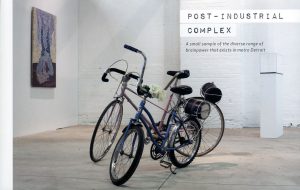ba-b&l takes Text-to-Speech audio files and custom-designed speakers to create a sound-encapsulated environment.
ba-b&l is a reconfigurable sound installation that plays digital audio generated from texts about language development in ancient Mesopotamia (appropriated and reworked from Neal Stephenson’s novel “Snow Crash,” published in 1992). The texts have been sliced into the most basic elements of language – phonemes (the building blocks that are used to construct words). These are layered to create a real-time mix played on multiple sets of custom speakers.
In 2001, we built two different sound installations to be exhibited simultaneously in Dayton, Ohio, USA, and Manchester, UK. We had started an unincorporated artist-run non-profit organization called ‘artcore’ to curate and present the rapid prototype art exhibition ‘Intersculpt:Ohio 01’ at Archetype Gallery in Dayton. Our colleague, Keith Brown, had founded Fast-uk and was presenting the exhibition [inter:face]01 at Righton Gallery in Manchester. Both versions used the same custom audio speakers that we designed and made. The spherical cases the speakers were housed in were digitally modeled, produced on a stereolithography apparatus, molded in silicone, and multiples cast in urethane.
The size of the spheres was so that they would fit into circular holes in the staircase at Archetype Gallery. The set for Dayton was cast in white urethane, and the set for Manchester was green. Each location had its own configuration, layout, and custom audio. The Dayton installation was titled ‘ba-b&l’ – based on the phonetic representation of “Babel” and “babble” and sounded like a capella techno music. The Manchester installation was titled ‘incantation’ and mimicked the intonation and rhythms of Gregorian chant music.
APPROACH
When we read Neal Stephenson’s formative cyberpunk novel “Snow Crash,” we got excited by the idea of neurolinguistic hacking.
In the novel, a neurolinguistic hacker is someone with the ability to reprogram minds with verbal streams of data. We took chunks of text from Stephenson’s novel about Sumerian being the firmware and BIOS for the human brain and fed them into a Text-to-Speech engine, recording the output. We then chopped these up in audio editing software into individual phonemes – the abstract units of a language’s phonetic system corresponding to a set of similar speech sounds (there are 44 phoneme sounds in the English language). We used the database of resulting short slices of audio as the raw material to be played as arbitrary sequences in the various ba-b&l installations. For these works, we are relying on apophenia—the human tendency to make connections and see patterns that are not there. People are always convinced that they hear words and phrases in the audio. Our favorites that audience members have shared are, “…pretty Bauhaus…” and “…the root of it…”
IMPACT
In 2012, we were invited to submit work for ‘Post-Industrial Complex,’ an exhibition and sourcebook that celebrates the ingenuity and adaptivity of the Detroit community. Co-curated by Katie Grace McGowan and Jon Brumit, ‘Post-Industrial Complex’ was held at the Museum of Contemporary Art Detroit in the summer of 2012. The project explored the ingenuity and adaptivity of human-scale production in Detroit, aiming to disrupt the notion that only one narrative of the city exists and provide insight into everyday creativity.
For this opportunity, we decided to rework ba-b&l. The original 2001 work focused on the perceptual interactions between the audience’s auditory and analytic processes, which were engaged in deciphering the babble to make meaning. With the 2012 iteration, we wanted to explore the audience’s capacity to interact with the work physically in a way that triggers the intact texts to be played. We redesigned the electronics, added sensors, and remade the database of audio samples with current technology. The original installations used multiple portable CD players. We replaced these with digital audio players for the 2012 version. We titled this version ‘ba-b&l (11111011100)’, which is binary for 2012.
PUBLICATIONS

Post-Industrial Complex: A small sample of the diverse range of brainpower that exists in metro Detroit
Museum of Contemporary Art Detroit, 2013.
ISBN 978-0-9823896-2-1
DETAILS
Date: 2012
Location: MoCAD, Detroit, Michigan, USA
Client: Self-initiated
Schedule:
Design: Winter 2011
Completed: Spring 2012
Funders:
Self-funded
Team:
Cézanne Charles (rootoftwo)
John Marshall (rootoftwo)
Dimensions: 12’ (L) x 3’ (W) x 12’ (H)
Media: MDF, urethane, Arduino microcontrollers, speakers,
digital audio, sensors.